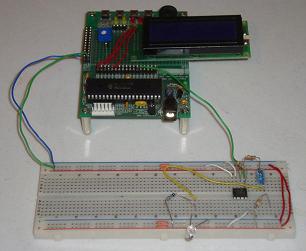An Overview Of The Infrared IR Receiver
In order to receive, amplify and decode the IR signal sent by the Direct TV remote control, a series of tricks and firmware fun were necessary. Along with some oscilloscope time to figure out what the signals actually looked like. In the end, there was no real mystery as to how to receive commands from the Direct TV remote control, it was just a matter of going one by one to figure out the unique signal that was generated for each individual button. The pulsing routines were standard and no unknowns really creeped in, once the core signal was analyzed in the theory section.

What To Do Now
There is no real standard for infrared remote controls, which means most remote controls will act differently unless they are a universal remote, but that's a special case. Infrared communication is a quick and easy way to get a wireless setup going, with virtually unlimited direction with which to take this kind of functionality. The key limitation of infrared is the need to have line of sight. This is the price we have to pay for the ease with which infrared communication is built.
Conclusion
Understanding how remote controls work, and how to actually receive data from them has always been a curiousity of mine. I hope it was for you as well, as it's no longer a real mystery to me. Most modern remote controls seem to operate in the same fashion, it's just a matter of brute-forcing your way through all the buttons to find their unique signature. A slow process, but the reward is being able to use the remote to control whatever you want.
If you have any further questions, I implore you...don't be shy, take a look at the forums or ask a question there. I check them out regularly and love getting comments & questions.
In order to receive, amplify and decode the IR signal sent by the Direct TV remote control, a series of tricks and firmware fun were necessary. Along with some oscilloscope time to figure out what the signals actually looked like. In the end, there was no real mystery as to how to receive commands from the Direct TV remote control, it was just a matter of going one by one to figure out the unique signal that was generated for each individual button. The pulsing routines were standard and no unknowns really creeped in, once the core signal was analyzed in the theory section.

What To Do Now
There is no real standard for infrared remote controls, which means most remote controls will act differently unless they are a universal remote, but that's a special case. Infrared communication is a quick and easy way to get a wireless setup going, with virtually unlimited direction with which to take this kind of functionality. The key limitation of infrared is the need to have line of sight. This is the price we have to pay for the ease with which infrared communication is built.
Conclusion
Understanding how remote controls work, and how to actually receive data from them has always been a curiousity of mine. I hope it was for you as well, as it's no longer a real mystery to me. Most modern remote controls seem to operate in the same fashion, it's just a matter of brute-forcing your way through all the buttons to find their unique signature. A slow process, but the reward is being able to use the remote to control whatever you want.
If you have any further questions, I implore you...don't be shy, take a look at the forums or ask a question there. I check them out regularly and love getting comments & questions.